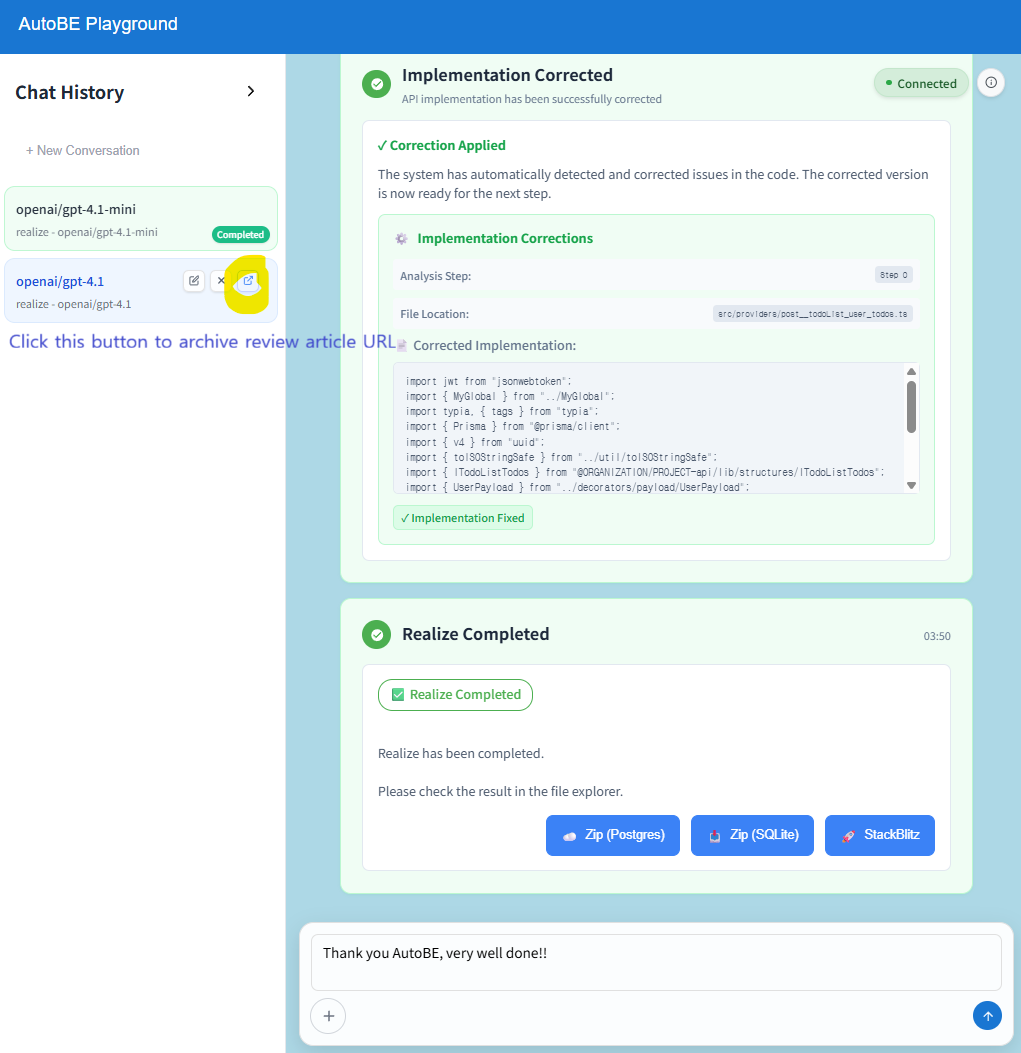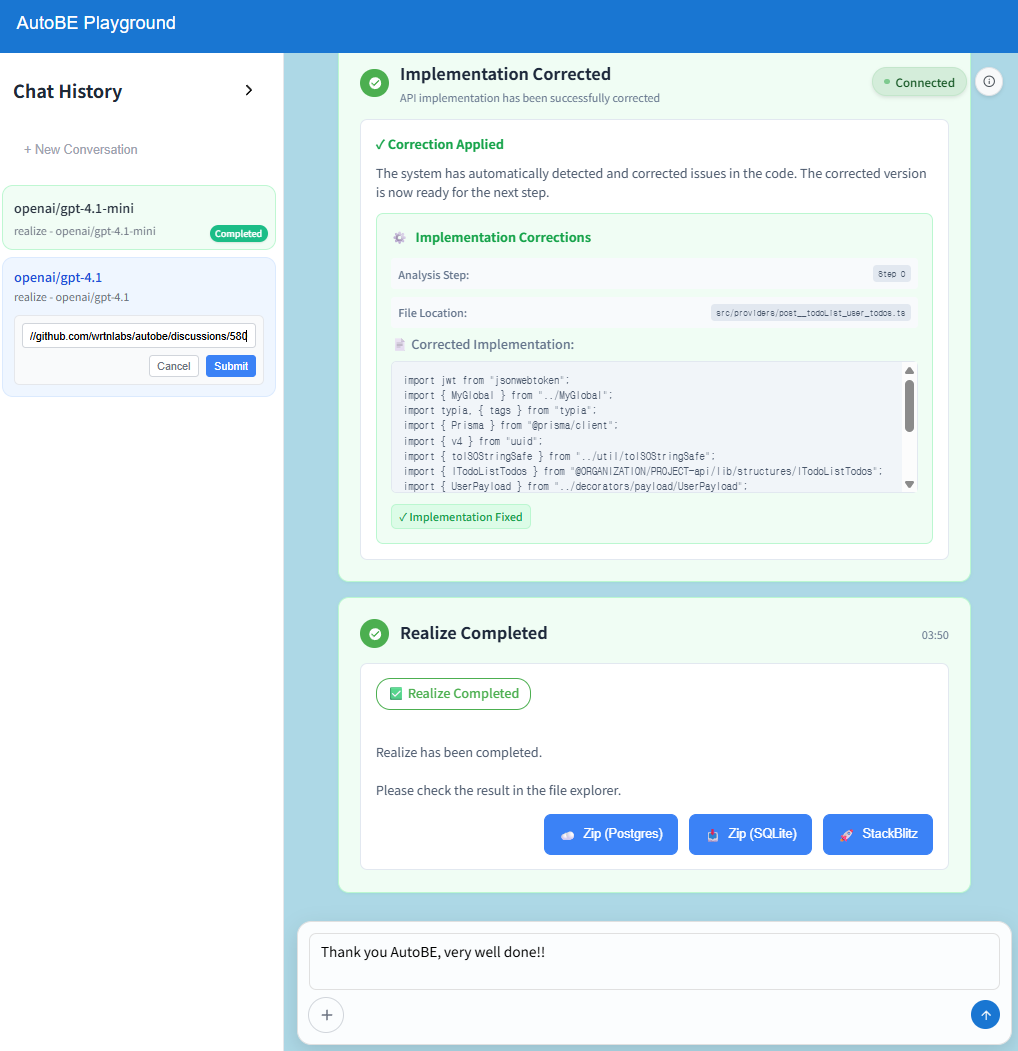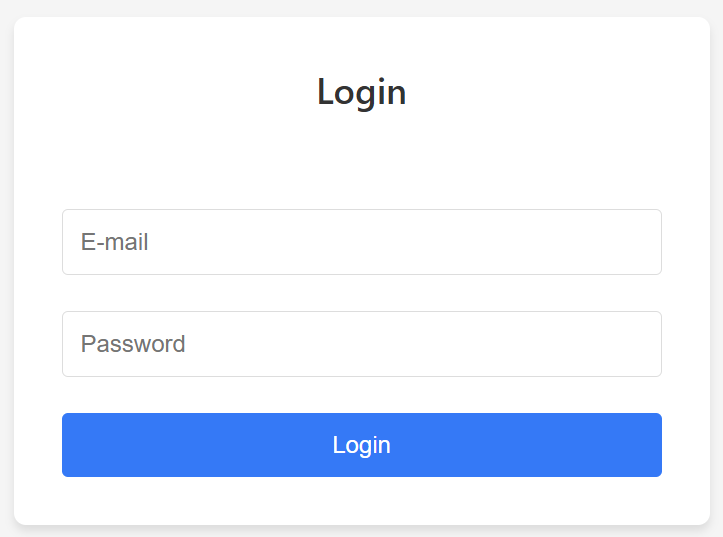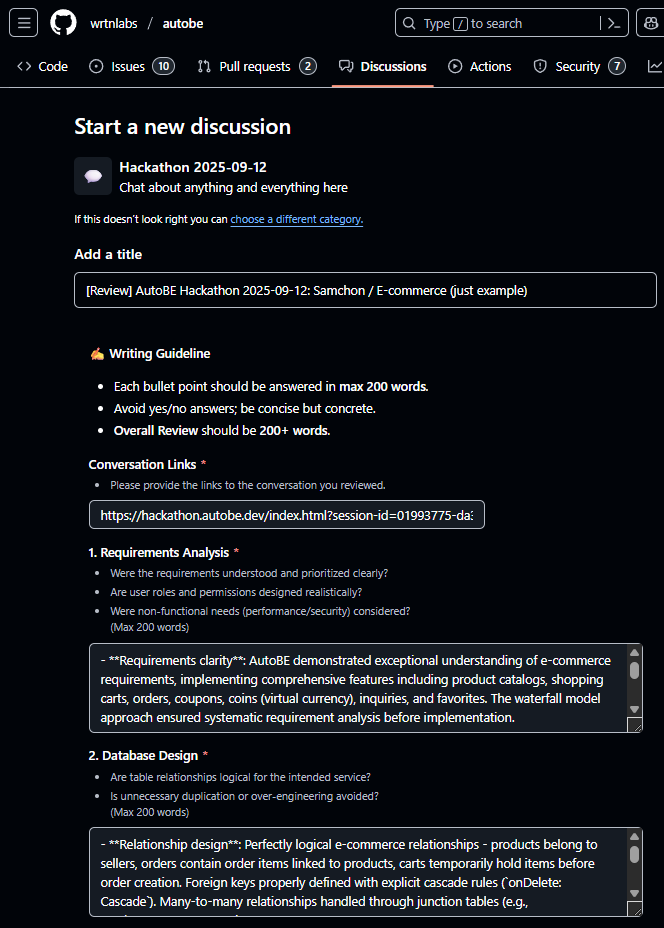1. Overview
Access the URL above to create backend applications with AutoBE and share your review.
Use the AI models in the order of (openai/gpt-4.1-mini -> openai/gpt-4.1), and you are free to choose the topic of your backend application.
After completing backend application generation with each AI model, please write a review post at https://github.com/wrtnlabs/autobe/discussions/new?category=hackathon-2025-09-12 and record it in your AutoBE chat session.
Our AutoBE team will continue to develop and improve AutoBE based on your detailed and honest reviews. The best reviewer will receive a prize of $2,000, the second best will receive $1,000, and all other participants will receive $50.
If you have any questions during the hackathon, please feel free to ask in our Discord channel at https://discord.gg/aMhRmzkqCx . We look forward to seeing your amazing reviews at the hackathon. Thank you.
- Start Time: 2025-09-12, 08:00:00 AM (PDT, UTC-7)
- End Time: 2025-09-14, 23:59:59 PM (PDT, UTC-7)
2. Sign Up
Please access the hackathon URL https://hackathon.autobe.dev .
Enter your email and password to log in.
The email should be the one you entered during your AutoBE hackathon registration, and the password is included in the AutoBE instruction email we sent you.
3. AI Model Specification
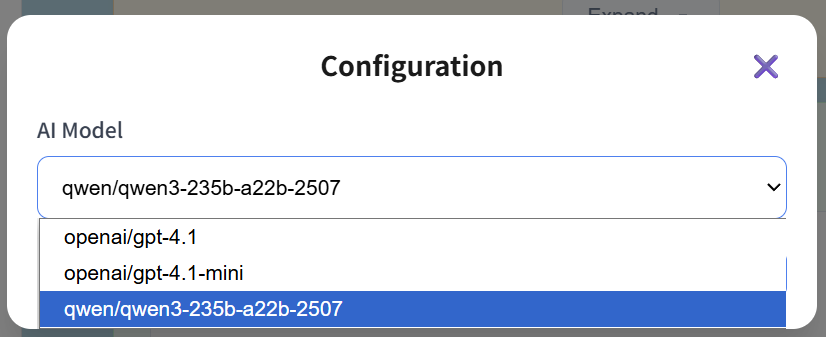
AI Model Usage Order:
openai/gpt-4.1-mini->openai/gpt-4.1
Start a new chat and select the AI model to use. For your first chat, please select openai/gpt-4.1-mini.
openai/gpt-4.1 can only be used after generating a backend application with openai/gpt-4.1-mini and writing a review post. Therefore, please fully experience openai/gpt-4.1-mini before creating backend applications with openai/gpt-4.1.
qwen/qwen3-next-80b-a3b-instruct is included for fun. Since qwen/qwen3-next-80b-a3b-instruct has a very low success rate for backend application generation, please use it out of curiosity after completing all the hackathon tasks, if you have time.
openai/gpt-4.1-mini(essential)openai/gpt-4.1(essential, but after review mini)qwen/qwen3-next-80b-a3b-instruct(optional, low success rate)
3.1. openai/gpt-4.1-mini
Todo
| Analyze | actors: 3, documents: 10 | |
| Prisma | namespaces: 3, models: 8 | |
| Interface | operations: 49, schemas: 63 | |
| Test | functions: 46 | |
| Realize | functions: 49 |
Bbs
| Analyze | actors: 3, documents: 11 | |
| Prisma | namespaces: 4, models: 8 | |
| Interface | operations: 48, schemas: 64 | |
| Test | functions: 52 | |
| Realize | functions: 48 |
| Analyze | actors: 4, documents: 12 | |
| Prisma | namespaces: 5, models: 17 | |
| Interface | operations: 105, schemas: 118 | |
| Test | functions: 94 | |
| Realize | functions: 105 |
Shopping
| Analyze | actors: 4, documents: 12 | |
| Prisma | namespaces: 10, models: 40 | |
| Interface | operations: 211, schemas: 248 | |
| Test | functions: 177 | |
| Realize | functions: 211 |
This is the model you’ll use first.
As a small and affordable model, it can create backend applications cost-effectively.
However, due to its size limitations, it may not perform deep requirements analysis well. The quality of various documents such as requirements analysis reports and ERD explanations may be compromised. Additionally, it sometimes fails to resolve compilation errors, causing the backend applications generated by AutoBE to fail to build.
You can use the openai/gpt-4.1-mini model up to 3 times in this hackathon, so please experience AutoBE from various angles with different topics.
3.2. openai/gpt-4.1
Todo
| Analyze | actors: 1, documents: 11 | |
| Prisma | namespaces: 3, models: 4 | |
| Interface | operations: 15, schemas: 21 | |
| Test | functions: 20 | |
| Realize | functions: 15 |
Bbs
| Analyze | actors: 2, documents: 11 | |
| Prisma | namespaces: 6, models: 12 | |
| Interface | operations: 59, schemas: 63 | |
| Test | functions: 93 | |
| Realize | functions: 59 |
| Analyze | actors: 3, documents: 12 | |
| Prisma | namespaces: 10, models: 56 | |
| Interface | operations: 245, schemas: 285 | |
| Test | functions: 257 | |
| Realize | functions: 245 |
Shopping
| Analyze | actors: 3, documents: 12 | |
| Prisma | namespaces: 10, models: 46 | |
| Interface | operations: 278, schemas: 255 | |
| Test | functions: 286 | |
| Realize | functions: 278 |
You can use this model after creating a backend application with
openai/gpt-4.1-miniand writing a review post.
As a large and expensive model, you can create the most perfect backend applications with openai/gpt-4.1.
It excels at deep requirements analysis and handles unreasonable demands well, such as “I’m the chairman of Samsung Electronics, create an ERP system considering our company’s organizational characteristics, don’t ask any questions and do it yourself using all your knowledge.” The quality of requirements analysis reports and ERD explanations is excellent, and it understands and resolves compilation errors very well.
However, it is expensive. For an Amazon-level shopping mall, it costs approximately $400. Therefore, we cannot provide unlimited access to this model in the hackathon. It is limited to one use after completing the openai/gpt-4.1-mini mission.
3.3. qwen/qwen3-next-80b-a3b-instruct
Todo
| Analyze | actors: 1, documents: 10 | |
| Prisma | namespaces: 2, models: 3 | |
| Interface | operations: 13, schemas: 17 | |
| Test | functions: 58 | |
| Realize | functions: 13 |
Bbs
| Analyze | actors: 2, documents: 6 | |
| Prisma | namespaces: 6, models: 20 | |
| Interface | operations: 44, schemas: 45 | |
| Test | functions: 80 | |
| Realize | functions: 44, errors: 1 |
| Analyze | actors: 3, documents: 11 | |
| Prisma | namespaces: 10, models: 39 | |
| Interface | operations: 68, schemas: 75 | |
| Test | functions: 68 | |
| Realize | functions: 68, errors: 1 |
Shopping
| Analyze | actors: 3, documents: 11 | |
| Prisma | namespaces: 10, models: 47 | |
| Interface | operations: 172, schemas: 171 | |
| Test | functions: 360 | |
| Realize | functions: 172, errors: 4 |
The cheapest and lightest model, it can run smoothly even on developers’ laptops.
However, it can only create simple backend applications at the level of a to-do list, and it often breaks down when requirements become slightly complex or extensive.
This model is included for fun, and reviews for this model are not mandatory. Please use it out of curiosity when you have time.
4. Conversation
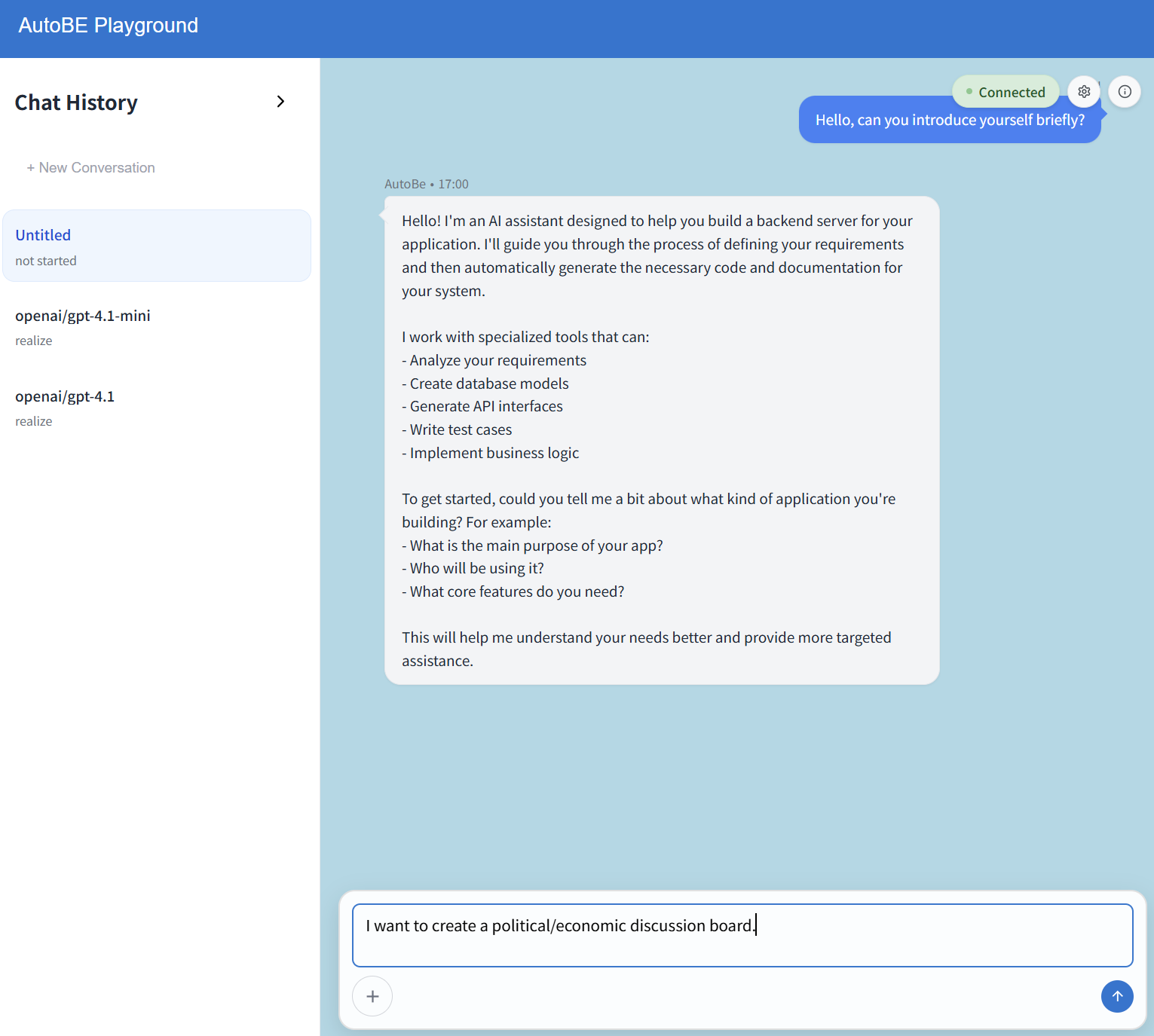
Create a backend application by conversing with the AutoBE chatbot.
Below is an example used when creating a political/economic discussion board. However, please avoid conversations like “just do it for me” as shown below. Please discuss your requirements thoroughly with the AI.
I want to create a political/economic discussion board.
Since I’m not familiar with programming, please write a requirements analysis report as you see fit.
After sufficiently discussing your requirements with the AutoBE chatbot, AutoBE will soon publish a requirements analysis report. Publishing the requirements report takes about 5-15 minutes, so you can do other work or take a short break and return later.
Afterward, enter the following conversations according to each step, and AutoBE will proceed with the work in order to create the backend application. From this point, each step takes considerably longer, so you can do other work in the meantime.
- Design the database schema.
- Create the API interface specification.
- Make e2e test functions.
- Implement the API functions.
For approximate time estimates for each step, please refer to the example screenshots for each model in the previous 3. AI Model Specification.
4.1. Analyze
AutoBE will define requirements based on your conversation and publish an analysis report.
- Requirements Analysis Report Examples:
AutoBE will continuously ask questions and continue discussions about your backend application requirements. When AutoBE determines that sufficient requirements have been derived, it will ask what story to use for the requirements analysis report. If you agree at this point, the requirements analysis report will be published.
If AutoBE’s questions are too detailed or if you don’t know much about the topic you want to create, ask AutoBE to stop asking questions and define requirements at its discretion. Then AutoBE will make its own judgment to define requirements and publish an analysis report.
Please read the published requirements analysis report and write a review post. Please examine whether AutoBE properly derived the requirements you wanted, whether it omitted important matters, or whether it defined requirements in unnecessary detail, and comment on these aspects.
4.2. Database Design
Based on the requirements analysis report, AutoBE will design database entities, write Prisma ORM schemas, and publish ERD (Entity Relationship Diagram) and explanations.
- DB Design Examples (ERD and Explanations)
You should mainly review the ERD (Entity Relationship Diagram) and the ERD.md file containing its detailed explanation.
Please review whether the DB design is sufficiently reasonable and valid, whether it properly reflects what was defined in the requirements analysis report, and whether it properly follows normalization and integrity principles.
4.3. API Specification
Based on the requirements analysis report and DB design, AutoBE will write API interface specifications (Swagger/OpenAPI) and generate NestJS controllers and DTO (Data Transfer Object) code.
- API Spec Examples
- To Do List: API Controllers / DTO Structures
- Reddit like Community: API Controllers / DTO Structures
- Political/Economic Discussion Board: API Controllers / DTO Structures
- E-Commerce: API Controllers / DTO Structures
Please review each API controller and DTO (Data Transfer Object) code to evaluate whether the API design is sufficiently reasonable and valid, and whether the documentation level is sufficient and easy to understand.
Don’t be surprised that there is no logic code in the API controllers. The current stage is only for API spec design, and actual API implementation is done in the 4.5. API Implementation stage.
@Controller("/auth/customer")
export class AuthCustomerController {
/**
* Register new customer in 'shopping_mall_ai_backend_customers', issuing
* tokens.
*
* Customer registration endpoint for shopping mall service. It creates a new
* member account, requiring email, phone number, secure password hash, legal
* name, and (optional) nickname, mirroring the
* 'shopping_mall_ai_backend_customers' schema. The flow issues JWT tokens,
* sets 'is_active' and 'is_verified' states, and snapshots 'created_at' and
* 'updated_at' for audit. Security policies enforce uniqueness of email and
* phone, password hash integrity, and activity tracking (last_login_at null
* at registration). New account is returned with authentication tokens for
* API use. If duplicate, validation fails. The schema links this table to
* customer withdrawal/session entities for lifecycle management. Error
* scenarios include unique validation, identity verification failure, or
* transaction rollback. Related operations: customer login, token refresh,
* withdrawal. Only customers who complete onboarding will be 'is_active'.
*
* Field mapping:
*
* - Email, phone_number, password_hash, name from schema for onboarding
* - Is_active true, is_verified as appropriate
* - Last_login_at null on join, set on first login
*
* All core authn details are present in the schema. Do not create extra
* fields.
*
* @param connection
* @param body Customer registration for shopping mall service
* @setHeader token.access Authorization
*
* @nestia Generated by Nestia - https://github.com/samchon/nestia
*/
@TypedRoute.Post("join")
public async join(
@TypedBody() body: IShoppingMallAiBackendCustomer.IJoin,
): Promise<IShoppingMallAiBackendCustomer.IAuthorized> {
body;
return typia.random<IShoppingMallAiBackendCustomer.IAuthorized>();
}
}4.4. E2E Test Functions
Based on the API interface specifications, AutoBE will write e2e test code.
- E2E Test Code Examples
Please examine these e2e test codes to determine whether each e2e test scenario is sufficiently reasonable and valid. Also, evaluate whether the e2e test implementation code is readable for humans, or whether it is overly complex or difficult.
Please provide your honest and candid review of the e2e test code.
4.5. API Implementation
Based on all the previous processes, AutoBE will write API logic code.
- API Implementation Code Examples
Please also examine the overall API logic implementation code and write an honest and detailed review.
Your reviews are a great help in the development of AutoBE.
5. Review
https://github.com/wrtnlabs/autobe/discussions/new?category=hackathon-2025-09-12
After creating a backend application with AutoBE, please write a review post at the URL above.
You need to provide the following 8 pieces of information:
Your honest and detailed review will greatly help in the development of AutoBE. Thank you.
- Chat Session URL
- Enter the URL of the chat session being reviewed
- ex: https://hackathon.autobe.dev/index.html?session-id=01993775-da38-731f-a4d4-8edd36653ba3
- Review of the Requirements Analysis Report
- Review of the DB Design
- Review of the API Specification
- Review of the E2E Test Code
- Review of the API Implementation Code
- AutoBE’s Level Definition (junior / mid / senior)
- Overall Review of AutoBE
After that, copy the review article URL and input it into the AutoBE hackathon application.
